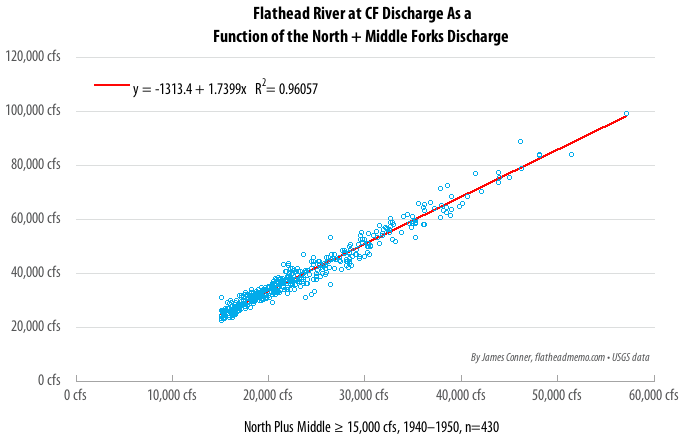How high the Flathead River without Hungry Horse Dam?
The short answer, by my calculations, was 16.4 feet on the gage at Columbia Falls yesterday, three feet over flood stage, running just under 76,000 cubic feet per second.
The actual values at 1330 MDT yesterday were 13.57 feet and 48,200 cfs (mainstem gage). Hungry Horse Dam was discharging 3,500 cfs (the value changed by the hour), holding back almost 30,000 cfs. Were the dam’s reservoir not absorbing the South Fork Flathead’s flow (gage), fields and yards in the Flathead Valley along the river would be under water in a moderate flood comparable to the floods of 1974 and 1975. Before the dam, significant floods occurred approximately twice a decade (hydrographs of the Flathead’s greatest floods).
Almost all of the water in the river during this stage of spring runoff is coming from the Flathead River’s two wild (unregulated, in river manager parlance) forks, the North Fork (gage) and the Middle Fork (gage), each supplying a bit less than a third of the volume of the mainstem river. Because we know from pre-HHD streamflow measurements that when the North and Middle Forks was high, the South Fork was high, we can use the sum of the North and Middle Forks (data, Excel spreadsheet) to estimate what the stage and discharge of the mainstem river would be without the dam.
 PDF for printing.
PDF for printing.Here’s the relationship of the sum of the discharge of the North and Middle Forks to the discharge of the mainstem Flathead River prior to the construction of Hungry Horse Dam. The goodness of fit, as indicated by the R-squared statistic, is excellent. Download curve fit data.
And here’s the hydrograph of the Flathead’s flood of 1948, with the hydrograph calculated from the sum of the North and Middle Forks.
When I moved to the Flathead in the 1970s, Bureau of Reclamation spokesmen used to issue in high water years statements explaining how much higher the water would be without Hungry Horse Dam. Those announcements were considered newsworthy. Now the general attitude of almost everyone seems to be that the regulated state of the mainstem Flathead River is the natural order of things. It’s not.



